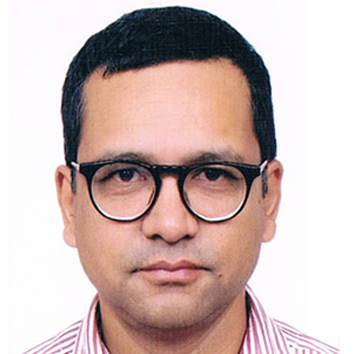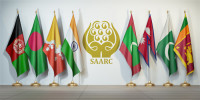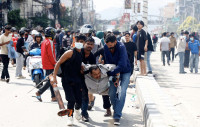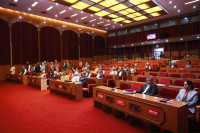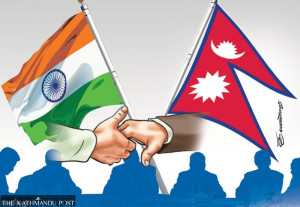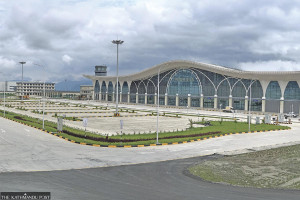Columns
Research going local
Unlike 25 years ago, academics in many parts of the country are engaging in research.
Pratyoush Onta
When it comes to the subject of research in Nepal, various academics have complained about the lack of research “culture”, “quality” and funding in Nepal. With respect to the academic journals that publish the written outcomes of research in the social sciences broadly defined, I have critiqued their irregularity (“For a plural publication landscape”, March 31, 2023) and the seemingly poor quality of the peer review process adopted by them (“Reading Nepali journals online”, June 7, 2024). But let us pause—borrowing the words of historian Surabhi Pudasaini—in this narrative of lack. Writing about the “architecture of production in the Gorkhali Polity” from the late 18th to the mid-20th century in the journal Studies in Nepal History and Society in 2024, she argues that the “focus on lack has … forestalled a pursuit of what was present.” She further adds, “Pursuing presence…as a historiographical posture opens up all manner of insights…”
Following Pudasaini, if we pursue presence in the field of social science research in Nepal, what insights might we gain? It is not easy to answer this question without meticulously reviewing the actual research taking place in degree-granting higher education institutions (HEIs) and other research-executing entities that are spread across the country. While the research status of specific disciplines like history, sociology, anthropology, political science, geography, etc., has been reviewed occasionally, the nationwide study hinted at above has not been attempted recently.
That is not to say we cannot even begin to think about the question. For instance, one can pursue research presence in our country by examining the contents of the many journals available online in the Nepal Journals Online (NepJOL) portal managed by the Central Library of Tribhuvan University. The portal now hosts more than 545 Nepali journals from all over the country. Many of these journals are dedicated to the natural/life sciences, engineering and management. Many other multi-disciplinary social science journals publish research outcomes in quite a few disciplines, catering to the research interests of a wide swathe of faculty members in HEIs.
Here is what I noticed after examining the available contents of many social science journals in NepJOL over several days recently. First, these journals are now being published not only from bigger cities such as Biratnagar, Kathmandu and Pokhara but also from small towns such as Myanglung, Beni and Mangalsen. More importantly, the contents of these journals published from specific locations are being significantly supplied by researchers based near those locations. For instance, many contributors to Adhyayan Journal published by Mechi Multiple Campus in Bhadrapur, Jhapa district, are associated with that campus of Tribhuvan University. Similarly, many contributors to the first issue (2025) of the SMC Journal Shadananda Multiple Campus, published by Shree Shadananda Multiple Campus in Dingla, Bhojpur district, are associated with that campus. But there are also other interesting patterns: Contributors to volume 4 no 1 issue (2025) of AMC Multidisciplinary Research Journal published by Achham Multiple Campus in Mangalsen, Achham district, are not only associated with that campus but also several other institutions in at least eight other districts.
Many more examples could be cited. However, even the limited evidence provided here speaks volumes about the current research presence. Unlike 25 years ago, academics in many parts of the country, including those based in small towns, are engaging in some form of research and research-related writings. They are also engaged in publishing many such writings in academic journals. They are also doing all the pre-press work that makes such publications possible: Submission of articles, some kind of reviews of those submissions by journal editors and other readers, possibly some revisions of those contents by the author(s), the eventual formatting of the contents according to journal-specific style guidelines and their uploading in the NepJOL portal. All of this involves quite a bit of communication between authors, editors, reviewers, and academic administrators of institutions that publish the various journals.
The geographical spread of this research presence suggests that the research capacity of various competence levels has been decentralised. In other words, there are academics now spread throughout Nepal who have the competence to do some form of research and produce academic writing with the necessary narrative, citations and references.
Second, research seems to have gone more local. Let me explain this point by examining the contents of specific journals. Take, for instance, the new journal A Peer Reviewed Journal on Social Sciences published by Hetauda Campus in Hetauda, Makwanpur district. Apparently, this journal is published twice a year, but only its most recent issue (volume 2, no 2, August 2024) is available on NepJOL. Looking at its table of contents, three articles have the word “Makwanpur” in their titles. Two others are also based on research done in Makwanpur. So in total, five out of seven articles in this issue are based on research done in Makwanpur. And they cover issues such as governance of co-operatives, causes of student absenteeism, financial management of community colleges, and the impact of teachers’ qualifications on their classroom performance.
The first issue of the annual Academia Journal of Humanities and Social Sciences was published by Myagdi Multiple Campus in Beni, Myagdi District in 2024. Five of the 10 articles in this issue deal with the nearby city of Pokhara and/or Kaski District. The bi-annual Academia Research Journal is published by Mahendra Multiple Campus in Nepalgunj. Its volume 4 no 2 issue (2025) has seven articles related to Nepalgunj. Four other articles related to Jumla, Humla, Surkhet and Bardia, respectively, are also published in the same issue. The last two volumes of Adhyayan Journal (2024, 2025) published eight articles related to Eastern Nepal.
Other examples could be added, but I think the point has been made: Spatial localisation of research is happening across the country. However, I am not suggesting that only local research is happening. These journals also continue to publish many articles that have nothing to do with the region from where they are published.
Third, the publication of locality-related content in the magnitude noted above should make us think about another aspect of research presence: Production of knowledge about specific phenomena in localities that were either not studied earlier (apart from by local historians) or studied inadequately. Is this happening by design? The statements given on the journals’ websites do not say so explicitly. Hence, this could simply be because the authors who contribute to these journals mostly happen to be doing research in their nearby localities. In a funding-constrained research environment, it is not surprising if academics based in Hetauda do much of their research within the district of Makwanpur.
More close reading of these locality-specific articles will allow us to see the academic conversations of which they are a part and also judge their analytical quality. It will also enable us to collectively pursue other presences in the field of social science research in our country.




 7.12°C Kathmandu
7.12°C Kathmandu